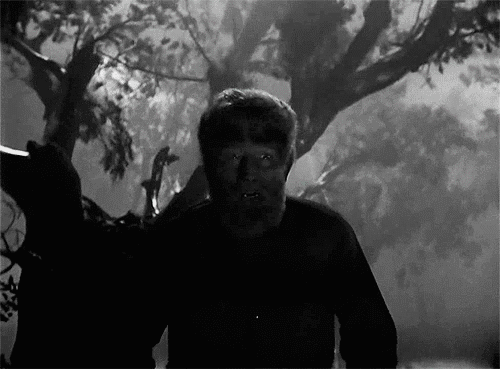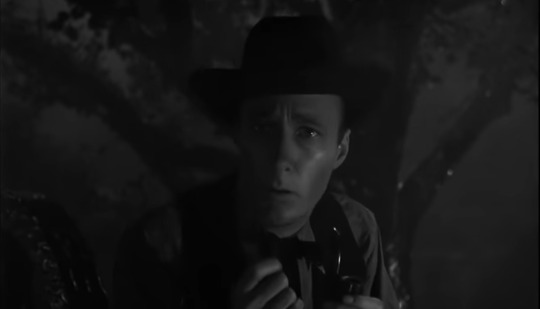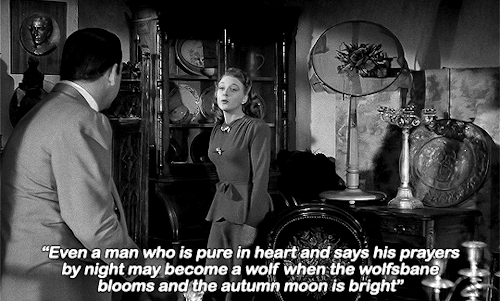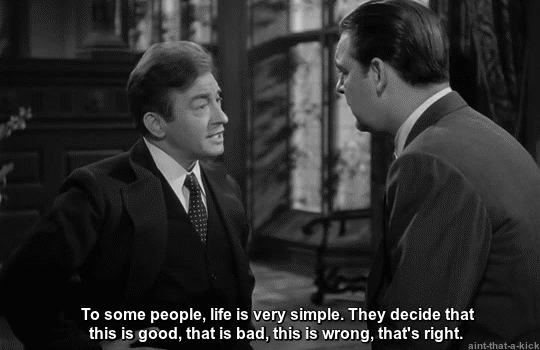#this is what i get for only watching psychological thriller and horror in my primitive years
Text
amateurish analysis of the Wolf Man (1941) cause I’m bored
The Wolf Man (1941), is one of my favorite movies of all time and, I’m convinced, one of the greatest horror movies (potentially also one of the greatest psych thrillers, too, and if I may be so bold, maybe even one of the best of the golden age of cinema, period) ever made. Most people are probably at least vaguely familiar with the image of Lon Chaney Jr. in his classic wolf man get up, stalking a foggy forest. Unfortunately, the actual plot of the film, its characters and themes, have failed for the most part to seep into the popular consciousness. Most people could tell you the basic tales of Frankenstein’s monster or Dracula, but probably not that of Larry Talbot. The wolf man is more famous for his part in the later, cheesier, and somewhat shallower ‘Monster rally’ flicks like Frankenstein meets the Wolf Man or House of Dracula (don’t get me wrong; I love those movies), than for his debut film. This is a damn shame, because iMO the Wolf Man is probably the best of the early Universal horror pictures, and a much smarter film than you might expect of an old black-and-white monster flick. Largely when read through the lens of a psychological tragedy instead of a simple monster story.
(More under the cut, and warning: long as fuck. If you read to the end you win a prize: my congratulations for wasting twenty minutes of your life on me. A lot of what I say here has been said elsewhere and better by others. I’ve just had werewolves on the mind lately and wanted to put some of my thoughts to paper. Or screen.)

First a brief overview of the story:
After years abroad in America, the tragic death of his his brother in a hunting accident brings Lawrence “Larry” Talbot, estranged son of stiff-necked patrician Sir John Talbot, home at last to the little Welsh village of Llanwelly.
While settling back in, Larry finds himself smitten by a local shopkeep’s daughter, Gwen Conliffe (Evelyn Ankers, one of my first screen crushes). Despite the fact that she’s engaged to be married, he manages to wring a not-date out of her. Of course, she does insist that her friend Jenny tag along, and the three visit a Roma camp just outside town.
While Jenny visits with the palm-reader Bela (Bela Lugosi, towards the end of his A-lister years), Larry and Gwen go for a moonlit stroll.
Bela sees a pentagram in Jenny’s hand and tells her to run. Moments later, Larry and Gwen hear a howl. Then a scream. Larry rushes towards the sound, to find Jenny being mauled by a massive wolf. Unfortunately, it’s too late for the girl, and before he can beat the animal to death with his new cane (topped with a silver wolf’s head, and purchased earlier from Gwen’s shop), it bites him, too.
The next morning, Larry is questioned by his father and the authorities, who tell him there was no dead wolf at the scene. Only the corpse of Bela, the fortune teller. He insists in vain that he killed a wolf, and tries to show them his wound, only to find it’s healed up.
Dun dun dun!
Gwen receives the calumny of the town for being out and about ‘unescorted’ with a man other than her fiancé. Larry on the other hand, is suspected in the deaths of both Bela and Jenny, and his mental state begins to unravel.
It all comes to a head a few days later when Larry speaks with Maleva, Bela’s sage old mother. She tells him that he was bitten by Bela, a werewolf, and now will become a werewolf himself. A shaken Larry shares his fears with Gwen, who is less than convinced. But Larry rushes home that night and transforms into a wolf-monster which then kills the town’s grave digger.
Now things really start to unravel. Larry awakens in his bedroom, covered in mud, with wolf tracks leading from the window. With the discovery of the grave-digger’s body, the men of Llanwelly become convinced there’s a wolf at large, and organize to hunt it down. Larry, now fully convinced he is a werewolf, tries in vain to convince his father and the town’s notables of such. He is dismissed and increasingly suspected of madness. Before Sir John goes out to join the hunt, Larry convinces him to take the silver cane with him.
The night of the hunt, Larry visits Gwen to tell her that he’s going away. But then he sees a pentagram in her hand--a sign that indicates to a werewolf his next victim. He runs home and begs his father to restrain him. Sir John obliges, hoping to show his son this madness is all in his head.
Of course, the restraints do not hold him, and soon the wolf man is stalking the woods again. Gwen rushes out to find Larry. Dodging the hunters, the wolf man Larry finds Gwen and attacks her. But before he can kill her, Sir John appears and manages to beat the monster to death with the silver cane.
Sir John and Gwen watch in horror as the wolf man transforms back into Lawrence Talbot.
Roll credits.
Summary over
What’s most interesting about the Wolf Man to me, is that it was not conceived as a monster movie. Not exactly, anyway. In Curt Siodmak’s original screenplay, Larry is bitten by a wolf and becomes convinced that he has become a werewolf himself. But we never see Larry in the shape of a wolf, and whether or not he has really become a monster or simply gone mad is left ambiguous. At the last moment, Universal decided they wanted a straightforward monster movie, and changes were made accordingly.
However, despite these alterations, it is still quite easy to read the film as a story of insanity and superstition, rather than one about monsters, and I wonder if this was not Siodmak’s intention, studio mandated rewrites notwithstanding. Even within the film’s own universe, more characters doubt the existence of werewolves than accept it. Unlike many monster (or ghost, or demon, etc.) movies, the supernatural skeptics are not portrayed as bullheaded or unreasonable, and there is no grand scene at the end where they realize their naturalistic errors.
Sir John for one has little patience for his son’s lycanthropic nonsense. He explains the legend of the werewolf as a primitive explanation for the duality of man, his capacity for both good and evil. When asked if he believes in werewolves, the town physician, Doctor Lloyd, tells Larry only that “a man lost in the mazes of his own mind may imagine that he’s anything”.
It is easy to watch the film and imagine that just maybe, Larry is lost in the mazes of his own mind, and there is never any monster at all, except the one he imagines himself to be (and thus “becomes” in spirit). When Bela in his wolf form bites Larry, we don’t see a monstrous hybrid, only an ordinary wolf (played by a German shepherd), which Larry beats to death with his cane. The film is told from Larry’s point of view, and before he is convinced of the existence of werewolves, we see nothing obviously supernatural. Only an ordinary wolf.
Only after Larry comes to believe in werewolves do we see an outwardly supernatural monster in the form of Larry’s own two-legged wolf man. Perhaps it’s Larry’s paranoia in the aftermath of the wolf attack that leads him to become a beast. But only in his head.
We never get any confirmation from the other characters that Larry is indeed a literal werewolf. When he kills his first victim, Richardson the gravedigger, you must watch Richardson’s face. He first spots the wolf man crouching under a tree, just before it lunges at him, but his expression isn’t “holy fuck what the hell is that thing?” it’s more “what’s that guy doing?”. Only when it springs for his throat does Richardson panic. It’s easy to imagine in the place of the monster, a maddened but very human Larry Talbot, probably barefoot and wild-eyed. Enough to unnerve Richardson and make him take a second look, but not enough to cause immediate and mortal terror, as we might expect if he was actually face to face with a supernatural monster.

Later, when the wolf man attacks Gwen, and Sir John rushes to her rescue, his face is again less that of a man who’s just been confronted by an honest to God werewolf, and more that of someone who’s just stumbled upon a man assaulting a young woman in the forest. Once he kills the wolf man and it slowly transforms back into Larry Talbot, there is certainly shock in Sir John’s face. But rather then the shock of witnessing a magic transfiguration, might this not be the shock of a man who’s realized what his own son is capable of?
Gwen, upon witnessing the same reversion to Larry’s human form, exclaims “Larry!” But Evelyn Ankers delivers the line in such a way that I hear less “werewolves are real?” and more “I can’t believe Larry Talbot just tried to strangle me.”
So if we grant that Larry has not actually become a wolf, and is instead fallen prey to superstition and his own psyche, whence comes the transformation? Why does he believe he is a werewolf? Why does he kill people?
Lon Chaney Jr. was great at playing sympathetic (and sometimes pathetic) characters that you just can’t help but feel for. His performance makes it hard not to like Larry, who seems every bit the put-upon everyman.
But long before he is ever bitten by the beast, there are indications that Larry Talbot has got a darker side.
Towards the beginning of the film, as mentioned earlier, he becomes smitten by Gwen Conliffe. But the manner in which this happens is quite disturbing. He is tinkering with his father’s telescope, and using it to scout out the town. That’s when he spots Gwen through her bedroom window. Rather than avert his eyes, he focuses the lens and watches for a bit, before going down to the shop to say hello.
The “wolf” man, indeed.
When he goes down to the shop to flirt, she’s not particularly interested. Much less so when he alludes to the earrings she keeps on her bureau in her room, spotted through the telescope. But Larry is pushy, and won’t take no for an answer. He insists on a date (”I’ll pick you up at eight”). She says no. He shows up at eight anyways. She caves.
I’m willing to chalk up some of the screenplay’s depiction of such unsettling behavior to shifting social mores and old-style sexism, but even in the 1940s watching a girl through her bedroom window was beyond the pale. So I think at least some of this was intentional on Siodmak’s part.
So it would seem the bite of the werewolf did not make Larry into a predator--he already had that side to him. In fact, when he first visits Gwen’s shop, in the face of his bold advances, she sardonically offers to sell him a cane topped with a wooden dog’s head (”how about a little dog? That would suit you!”). Larry says that won’t do, and the narrative agrees. Because next she suggests a cane capped with a silver wolf. That suits him, agree not only Gwen and the script, but also Larry himself, because he buys it.

Dogs are a byword for lechery and boorishness, but wolves are a byword for much worse: rapacity, savagery, bloodlust, unbridled lust.
What’s the significance of Larry choosing a wolf over a dog? Is there any? Am I overthinking this? Yeah, probably. You tell me.
So Larry goes with Gwen and Jenny to the Roma camp. He’s insistently flirting with Gwen when they hear the howl and the scream that alert them to Jenny’s peril. Larry rushes in to rescue Jenny, and though she’s already dead, he manages to kill the wolf with his cane.
Despite the selflessness of his act (sidenote: abandoning the “it’s all in Larry’s head” interpretation for a moment, it’s been pointed out how ironic it is that Larry, who has been a bit of a creep up until now, does this one good deed and in doing so damns himself to become a monster), it is ultimately his persistence in pursuing Gwen that leads to his being bitten by the beast.
Is it the case that, once convinced he has been bitten by a werewolf and is therefore doomed to become one himself, Larry’s subconscious finds an excuse to vent the violent psychosexual impulses that have been lurking there all the while? After all, he’s a monster now. He can’t help it.
What triggers Larry’s first transformation? A few days after he’s bitten, he goes back to the Roma camp, ostensibly to blow off some steam at the fair. While there, he runs into Gwen again, who happens to be with her fiancé Frank Andrews. He and Andrews have a ‘friendly’ competition at the shooting gallery, but when Larry is presented with a target in the shape of a cardboard cut-out wolf, he freaks and bolts. This (and the subsequent werewolf-centric conversation he has with Bela’s mother, Maleva) are the immediate cause of his first outing as ‘the wolf man’, but it seems pertinent that it follows right on the heels of another tense interaction with Gwen and with the man that’s going to marry her.
Once he becomes the wolf man, his first victim is Richardson the grave digger. Richardson is a man. But Richardson’s death seems almost accidental. Larry runs across him and kills him out of principle. Gwen on the other hand, is built up by the narrative as his “perfect victim”. Larry is horrified when he sees the apparition of a pentagram in her palm, believing himself destined to kill her. Later, during the climax, he transforms and specifically hunts her in his wolf form.
In short, both the wolf man and Larry want Gwen.

So is the wolf man a manifestation of Larry Talbot’s (possibly thanatophilic) lust? His savage sexual hunger given free rein in the shape of the “wolf man”?
It’s certainly an interesting, if eDgY, interpretation, to see Larry Talbot not as a doomed everyman, but rather as a sexually driven serial killer. Or at least, I think so.
(Worth noting that the other werewolf in the film, Bela, also transforms after a one-on-one encounter with a young woman, Jenny. And her first question of the fortune teller is “can you tell me when I’m going to be married?”)
Usually I’m not a fan of lazy “it’s all in X character’s head!” interpretations. They often come across as uninspired and pointless. But in this case I believe the film itself bears it out (or can be plausibly watched that way).
As mentioned above, Sir John makes several speeches on the duality of man. The same duality we are shown with such clarity in Larry himself. Sir John is played wonderfully by Claude Rains (probably best known as Casablanca’s Capt. Renault, but also starring in Mr. Smith Goes to Washington and Lawrence of Arabia) and like I mentioned above, is never made a figure of fun or contempt for his disbelief in the supernatural, unlike so many similar skeptics in monster movies. At most, his skepticism is portrayed as tragic, in that he doesn’t believe until it’s too late. At least, it can be argued (as I’ve been doing here) he was right in that there were never any literal monsters.
It seems superfluous to have Sir John make so many erudite statements on the monstrosity and capacity for savagery that exists in man, if we are not to at least contemplate the possibility that this is enough to explain the events of the film, without recourse to the supernatural.
So what is Sir John’s role in his son’s transformation, literal or otherwise? First, it’s important to note that Larry’s presumably deceased mother is never so much as mentioned. I’m sure there’s something Freudian at work here, but I’m too lazy to work it out.
The main point is that it means Sir John is alone in dealing with his son. At the beginning of the film, Sir John, glad at Larry’s return from America, tells him (regarding the traditionally austere relationship between aristocratic fathers and sons) “between us there shall be no more such reserve”. Through the remainder of the film, he again and again counsels his son that there are no werewolves at all. He’s all rationality and cool-headedness. When he speaks with Maleva, the old sage who has been Larry’s go-to in all things werewolf, he angrily denounces her as “the old gypsy woman who’s been filling his head with this werewolf nonsense”.

But of course, all this is no to avail. Towards the end of the movie, when Larry (almost hopefully) wonders if the people of Llanwelly will storm Talbot Castle and lynch him, Sir John falls back on the certainties of aristocratic privilege to reassure his son (”You’re a Talbot! This is Talbot Castle! You think those people can come in here and drag you out?”) Regardless of whether or not Larry literally sprouts fur and fangs, Sir John’s reason and deconstruction of superstition is powerless to control the monster in his son. In the end, all he can do is crudely bludgeon it to death. Tragic, really.
A commentary on the impotence of psychiatric analysis? Probably not. Still interesting to think about.
Now on to Maleva. Maria Ouspenskaya plays the crude old crone stereotype, but I think there’s a bit more to the character. She’s the mother of Bela, the Roma fortune teller who ostensibly bites Larry. She is perhaps the only staunch believer in werewolfism in the film save Larry himself, once he becomes one (or believes he has become one, if you’re staying with me). When Larry visits her just before his first transformation, she gives him the low-down on werewolf lore (”whoever is bitten by a werewolf and lives, becomes a werewolf himself”). She also gives him a necklace marked with a pentagram (”the sign of the wolf”) and promises him it can break the evil spell.

He immediately gives it away to Gwen, hoping that it might protect her from himself, so we don’t get to see if it would have stopped the transformation. But when Gwen is attacked by the wolf man at the film’s climax, the charm does exactly jack-shit, so it seems unlikely. So Maleva, who believes in werewolves and even has magic charms meant to ward them off, is as powerless as the rational Sir John or Doctor Lloyd to contain the monster in Larry Talbot. The film itself never explains why the charm fails, but under the interpretation that Larry’s condition is mental rather than supernatural, of course a magic charm fails to keep him from killing.
Why does Maleva believe in werewolves? The film would immediately suggest it is because she comes from a culture that (in the movie at least) believes in them. But there’s another factor: she’s the mother of the other werewolf in the movie.
If we assume werewolves are just a manifestation of human lust, murderous or sexual or both, then it’s no wonder Maleva believes in werewolves: her son had the same monster in him as Larry Talbot. Explains her belief in the creature, and also why her charm doesn’t work. I suppose it might be easier to believe your loved one’s condition is a magic creature rather than simply a very sick human being.
So Maleva becomes as tragic a character as Sir John, both of whose explanations for the murderousness of their sons cannot do anything to actually restrain that murderousness.
(I haven’t and won’t even go into the implications of Larry killing Bela the werewolf with the phallic symbol that is a cane, and later being beaten to death by his father with the same, because it’s too on the nose and also it would probably fill another ten paragraphs)
Anyways, watch the Wolf Man. It’s a great movie. Whether you want to play psych 101 and overanalyze it like I’ve just done or just enjoy a straight up monster movie. The performances are great, the atmosphere is spooky, the score is fantastic. It’s a classic. Check it out.
And remember:
Even a man who is pure in heart and says his prayers by night, may become a wolf when the wolfsbane blooms, and the autumn moon is bright.
#horror#movies#analysis#faux psych bullshit#my rambling#the wolf man#Lon Chaney Jr.#claude rains#evelyn ankers#reposting after some touch ups#essay
7 notes
·
View notes